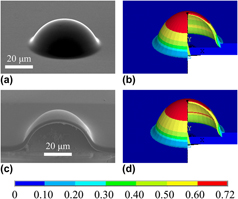Crossref Citations
This article has been cited by the following publications. This list is generated based on data provided by
Crossref.
Brown, Matthew S.
Brasz, C. Frederik
Ventikos, Yiannis
and
Arnold, Craig B.
2012.
Impulsively actuated jets from thin liquid films for high-resolution printing applications.
Journal of Fluid Mechanics,
Vol. 709,
Issue. ,
p.
341.
Meshcheryakov, Yuri P.
Shugaev, Maxim V.
Mattle, Thomas
Lippert, Thomas
and
Bulgakova, Nadezhda M.
2013.
Role of thermal stresses on pulsed laser irradiation of thin films under conditions of microbump formation and nonvaporization forward transfer.
Applied Physics A,
Vol. 113,
Issue. 2,
p.
521.
Sotrop, Jürgen
Kersch, Alfred
Domke, Matthias
Heise, Gerhard
and
Huber, Heinz P.
2013.
Numerical simulation of ultrafast expansion as the driving mechanism for confined laser ablation with ultra-short laser pulses.
Applied Physics A,
Vol. 113,
Issue. 2,
p.
397.
Ma, H.
and
Venugopalan, V.
2014.
Time-resolved digital holographic microscopy of laser-induced forward transfer.
Applied Physics B,
Vol. 114,
Issue. 3,
p.
361.
Fricke-Begemann, T.
Meinertz, J.
Weichenhain-Schriever, R.
and
Ihlemann, J.
2014.
Silicon suboxide (SiOx): laser processing and applications.
Applied Physics A,
Vol. 117,
Issue. 1,
p.
13.
Makrygianni, Marina
Papazoglou, Symeon
and
Zergioti, Ioanna
2015.
Wiley Encyclopedia of Electrical and Electronics Engineering.
p.
1.
Brasz, C. Frederik
Yang, Julia H.
and
Arnold, Craig B.
2015.
Tilting of adjacent laser-induced liquid jets.
Microfluidics and Nanofluidics,
Vol. 18,
Issue. 2,
p.
185.
Kang, Hyun Wook
and
Welch, Ashley J.
2015.
Enhanced coupling of optical energy during liquid-confined metal ablation.
Journal of Applied Physics,
Vol. 118,
Issue. 15,
Bert Huis in 't Veld
Overmeyer, Ludger
Schmidt, Michael
Wegener, Konrad
Malshe, Ajay
and
Bartolo, Paulo
2015.
Micro additive manufacturing using ultra short laser pulses.
CIRP Annals,
Vol. 64,
Issue. 2,
p.
701.
Xiong, Ruitong
Zhang, Zhengyi
Shen, Jianxin
Lin, Yafu
Huang, Yong
and
Chrisey, Douglas B.
2015.
Bubble Formation Modeling During Laser Direct Writing of Glycerol Solutions.
Journal of Micro and Nano-Manufacturing,
Vol. 3,
Issue. 1,
Feinaeugle, Matthias
Heath, Daniel J.
Mills, Benjamin
Grant-Jacob, James A.
Mashanovich, Goran Z.
and
Eason, Robert W.
2016.
Laser-induced backward transfer of nanoimprinted polymer elements.
Applied Physics A,
Vol. 122,
Issue. 4,
Munoz-Martin, D.
Brasz, C.F.
Chen, Y.
Morales, M.
Arnold, C.B.
and
Molpeceres, C.
2016.
Laser-induced forward transfer of high-viscosity silver pastes.
Applied Surface Science,
Vol. 366,
Issue. ,
p.
389.
Yung, Winco K. C.
Sun, Bo
Meng, Zhengong
Huang, Junfeng
Jin, Yingdi
Choy, Hang Shan
Cai, Zhixiang
Li, Guijun
Ho, Cheuk Lam
Yang, Jinlong
and
Wong, Wai Yeung
2016.
Additive and Photochemical Manufacturing of Copper.
Scientific Reports,
Vol. 6,
Issue. 1,
Turkoz, Emre
Deike, Luc
and
Arnold, Craig B.
2017.
Comparison of jets from Newtonian and non-Newtonian fluids induced by blister-actuated laser-induced forward transfer (BA-LIFT).
Applied Physics A,
Vol. 123,
Issue. 10,
Hu, Yongxiang
Cheng, Han
Xu, Jiaxi
and
Yao, Zhenqiang
2017.
A coupling model to simulate the dynamic process of blister-actuated nanosecond laser-induced forward transfer.
Journal of Physics D: Applied Physics,
Vol. 50,
Issue. 32,
p.
325305.
Solomon, Nicolae
and
Solomon, Iulia
2018.
Paint blistering affects quality of finished products.
Engineering Failure Analysis,
Vol. 92,
Issue. ,
p.
44.
Turkoz, Emre
Perazzo, Antonio
Kim, Hyoungsoo
Stone, Howard A.
and
Arnold, Craig B.
2018.
Impulsively Induced Jets from Viscoelastic Films for High-Resolution Printing.
Physical Review Letters,
Vol. 120,
Issue. 7,
Turkoz, Emre
Fardel, Romain
and
Arnold, Craig B.
2018.
Laser Printing of Functional Materials.
p.
91.
Goodfriend, N T
Heng, S Y
Nerushev, O A
Gromov, A V
Bulgakov, A V
Okada, M
Xu, W
Kitaura, R
Warner, J
Shinohara, H
and
Campbell, E E B
2018.
Blister-based-laser-induced-forward-transfer: a non-contact, dry laser-based transfer method for nanomaterials.
Nanotechnology,
Vol. 29,
Issue. 38,
p.
385301.
Turkoz, Emre
Kang, SeungYeon
Deike, Luc
and
Arnold, Craig B.
2018.
Subthreshold laser jetting via flow-focusing in laser-induced forward transfer.
Physical Review Fluids,
Vol. 3,
Issue. 8,





